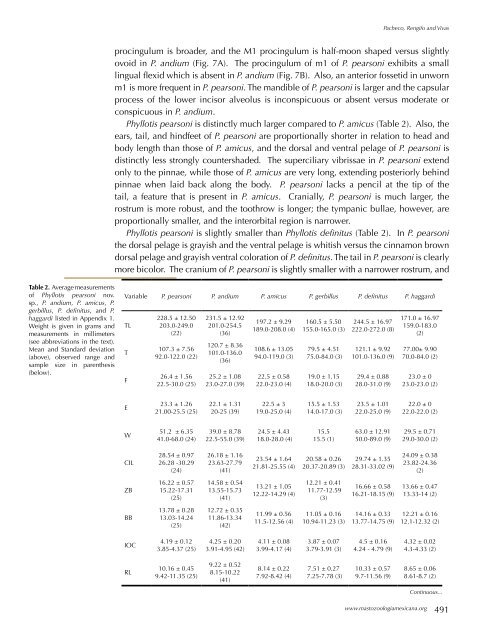therya-5_2
therya-5_2
therya-5_2
You also want an ePaper? Increase the reach of your titles
YUMPU automatically turns print PDFs into web optimized ePapers that Google loves.
Pacheco, Rengifo and Vivas<br />
procingulum is broader, and the M1 procingulum is half-moon shaped versus slightly<br />
ovoid in P. andium (Fig. 7A). The procingulum of m1 of P. pearsoni exhibits a small<br />
lingual flexid which is absent in P. andium (Fig. 7B). Also, an anterior fossetid in unworn<br />
m1 is more frequent in P. pearsoni. The mandible of P. pearsoni is larger and the capsular<br />
process of the lower incisor alveolus is inconspicuous or absent versus moderate or<br />
conspicuous in P. andium.<br />
Phyllotis pearsoni is distinctly much larger compared to P. amicus (Table 2). Also, the<br />
ears, tail, and hindfeet of P. pearsoni are proportionally shorter in relation to head and<br />
body length than those of P. amicus, and the dorsal and ventral pelage of P. pearsoni is<br />
distinctly less strongly countershaded. The superciliary vibrissae in P. pearsoni extend<br />
only to the pinnae, while those of P. amicus are very long, extending posteriorly behind<br />
pinnae when laid back along the body. P. pearsoni lacks a pencil at the tip of the<br />
tail, a feature that is present in P. amicus. Cranially, P. pearsoni is much larger, the<br />
rostrum is more robust, and the toothrow is longer; the tympanic bullae, however, are<br />
proportionally smaller, and the interorbital region is narrower.<br />
Phyllotis pearsoni is slightly smaller than Phyllotis definitus (Table 2). In P. pearsoni<br />
the dorsal pelage is grayish and the ventral pelage is whitish versus the cinnamon brown<br />
dorsal pelage and grayish ventral coloration of P. definitus. The tail in P. pearsoni is clearly<br />
more bicolor. The cranium of P. pearsoni is slightly smaller with a narrower rostrum, and<br />
Table 2. Average measurements<br />
of Phyllotis pearsoni nov.<br />
sp., P. andium, P. amicus, P.<br />
gerbillus, P. definitus, and P.<br />
haggardi listed in Appendix 1.<br />
Weight is given in grams and<br />
measurements in millimeters<br />
(see abbreviations in the text).<br />
Mean and Standard deviation<br />
(above), observed range and<br />
sample size in parenthesis<br />
(below).<br />
Variable P. pearsoni P. andium P. amicus P. gerbillus P. definitus P. haggardi<br />
TL<br />
T<br />
F<br />
228.5 ± 12.50<br />
203.0-249.0<br />
(22)<br />
107.3 ± 7.56<br />
92.0-122.0 (22)<br />
26.4 ± 1.56<br />
22.5-30.0 (25)<br />
231.5 ± 12.92<br />
201.0-254.5<br />
(36)<br />
120.7 ± 8.36<br />
101.0-136.0<br />
(36)<br />
25.2 ± 1.08<br />
23.0-27.0 (39)<br />
197.2 ± 9.29<br />
189.0-208.0 (4)<br />
108.6 ± 13.05<br />
94.0-119.0 (3)<br />
22.5 ± 0.58<br />
22.0-23.0 (4)<br />
160.5 ± 5.50<br />
155.0-165.0 (3)<br />
79.5 ± 4.51<br />
75.0-84.0 (3)<br />
19.0 ± 1.15<br />
18.0-20.0 (3)<br />
244.5 ± 16.97<br />
222.0-272.0 (8)<br />
121.1 ± 9.92<br />
101.0-136.0 (9)<br />
29.4 ± 0.88<br />
28.0-31.0 (9)<br />
171.0 ± 16.97<br />
159.0-183.0<br />
(2)<br />
77.00± 9.90<br />
70.0-84.0 (2)<br />
23.0 ± 0<br />
23.0-23.0 (2)<br />
E<br />
23.3 ± 1.26<br />
21.00-25.5 (25)<br />
22.1 ± 1.31<br />
20-25 (39)<br />
22.5 ± 3<br />
19.0-25.0 (4)<br />
15.5 ± 1.53<br />
14.0-17.0 (3)<br />
23.5 ± 1.01<br />
22.0-25.0 (9)<br />
22.0 ± 0<br />
22.0-22.0 (2)<br />
W<br />
51.2 ± 6.35<br />
41.0-68.0 (24)<br />
39.0 ± 8.78<br />
22.5-55.0 (39)<br />
24.5 ± 4.43<br />
18.0-28.0 (4)<br />
15.5<br />
15.5 (1)<br />
63.0 ± 12.91<br />
50.0-89.0 (9)<br />
29.5 ± 0.71<br />
29.0-30.0 (2)<br />
CIL<br />
28.54 ± 0.97<br />
26.28 -30.29<br />
(24)<br />
26.18 ± 1.16<br />
23.63-27.79<br />
(41)<br />
23.54 ± 1.64<br />
21.81-25.55 (4)<br />
20.58 ± 0.26<br />
20.37-20.89 (3)<br />
29.74 ± 1.35<br />
28.31-33.02 (9)<br />
24.09 ± 0.38<br />
23.82-24.36<br />
(2)<br />
ZB<br />
16.22 ± 0.57<br />
15.22-17.31<br />
(25)<br />
14.58 ± 0.54<br />
13.55-15.73<br />
(41)<br />
13.21 ± 1.05<br />
12.22-14.29 (4)<br />
12.21 ± 0.41<br />
11.77-12.59<br />
(3)<br />
16.66 ± 0.58<br />
16.21-18.15 (9)<br />
13.66 ± 0.47<br />
13.33-14 (2)<br />
BB<br />
13.78 ± 0.28<br />
13.03-14.24<br />
(25)<br />
12.72 ± 0.35<br />
11.86-13.34<br />
(42)<br />
11.99 ± 0.56<br />
11.5-12.56 (4)<br />
11.05 ± 0.16<br />
10.94-11.23 (3)<br />
14.16 ± 0.33<br />
13.77-14.75 (9)<br />
12.21 ± 0.16<br />
12.1-12.32 (2)<br />
IOC<br />
4.19 ± 0.12<br />
3.85-4.37 (25)<br />
4.25 ± 0.20<br />
3.91-4.95 (42)<br />
4.11 ± 0.08<br />
3.99-4.17 (4)<br />
3.87 ± 0.07<br />
3.79-3.91 (3)<br />
4.5 ± 0.16<br />
4.24 - 4.79 (9)<br />
4.32 ± 0.02<br />
4.3-4.33 (2)<br />
RL<br />
10.16 ± 0.45<br />
9.42-11.35 (25)<br />
9.22 ± 0.52<br />
8.15-10.22<br />
(41)<br />
8.14 ± 0.22<br />
7.92-8.42 (4)<br />
7.51 ± 0.27<br />
7.25-7.78 (3)<br />
10.33 ± 0.57<br />
9.7-11.56 (9)<br />
8.65 ± 0.06<br />
8.61-8.7 (2)<br />
Continuous...<br />
www.mastozoologiamexicana.org<br />
491



